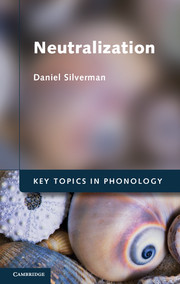Book contents
- Frontmatter
- Contents
- List of Figures
- Preface
- Acknowledgments
- 1 The rhyme and the reason of neutralization
- Part I Rhyme
- Section A Observation and description
- 2 Topology
- 3 Taxonomy
- 4 Typology
- Section B False positives
- Section C Explanation
- Section D Exemplification
- Part II Reason
- Glossary
- References
- Language index
- Subject index
4 - Typology
Published online by Cambridge University Press: 05 November 2012
- Frontmatter
- Contents
- List of Figures
- Preface
- Acknowledgments
- 1 The rhyme and the reason of neutralization
- Part I Rhyme
- Section A Observation and description
- 2 Topology
- 3 Taxonomy
- 4 Typology
- Section B False positives
- Section C Explanation
- Section D Exemplification
- Part II Reason
- Glossary
- References
- Language index
- Subject index
Summary
Far and away, the most thorough – and most thoroughly compelling – investigation into the typology of neutralization is that of Trubetzkoy. In his landmark work Principles of Phonology, posthumously published in 1939, Trubetzkoy is primarily concerned with inventorying the logical classifications of phonological oppositions and phonological processes. While much of the book is devoted to the typology of phonological oppositions (contrast), and sequential combinations (phonotactics), he also devotes some discussion to the typology of neutralization.
TRUBETZKOY (1939)
Neutralization is characterized by Trubetzkoy as a static distributional restriction on the phonological units that possess contrastive status in a particular language, that is, as the positional suspension of contrast, and not as the product of (dynamic) synchronic alternations. These latter forms are called morphonemes, and fall under the rubric of morphonology.
In order to understand the details of Trubetzkoy’s typology of neutralization, it is first necessary to have at least a partial understanding of his typology of phonemic distinctions, or the logical classification of distinctive oppositions. This is because, according to Trubetzkoy (1939), not every logical type of distinctive opposition is neutralizable. Rather, the extent to which neutralizing phonemes possess features in common is of paramount relevance. Those features that distinguish a set of neutralizing phonemes are referred to as marks, while the remainder – those features that are common to the neutralizing phonemes – are referred to as archiphonemes. The archiphoneme, therefore, is “the sum of distinctive properties that the two phonemes have in common” (p. 79); archiphonemes appear in positions of neutralization. (By convention, archiphonemes are written in upper-case letters; typically, the upper-case version of the Roman symbol approximating their phonetic value. For example, a nasal archiphoneme may be written “N”.)
- Type
- Chapter
- Information
- Neutralization , pp. 42 - 52Publisher: Cambridge University PressPrint publication year: 2012

